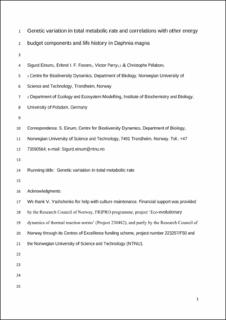| dc.contributor.author | Einum, Sigurd | |
| dc.contributor.author | Fossen, Erlend Ignacio Fleck | |
| dc.contributor.author | Parry, Victor | |
| dc.contributor.author | Pelabon, Christophe | |
| dc.date.accessioned | 2020-03-30T13:52:27Z | |
| dc.date.available | 2020-03-30T13:52:27Z | |
| dc.date.created | 2019-06-06T11:46:35Z | |
| dc.date.issued | 2019 | |
| dc.identifier.citation | Evolutionary biology. 2019, 46 (2), 170-178. | en_US |
| dc.identifier.issn | 0071-3260 | |
| dc.identifier.uri | https://hdl.handle.net/11250/2649464 | |
| dc.description.abstract | Much is known about the genetic variance in certain components of metabolism, most notably resting and maximum metabolic rate. This is in stark contrast to the lack of information on genetic variance in the metabolic rate of individuals that feed and express routine activity, and how this rate correlates with other components of the energy budget or life history traits. Here we quantify genetic variance in metabolic rate (MR) under such conditions, as well as food consumption, juvenile somatic growth rate and age at maturation under ad lib food availability in a set of 10 clones of Daphnia magna from a natural population. Broad sense evolvabilities (0.16–0.56%) were on the same order of magnitude as those typically observed for physiological and life history traits, and suggest that all these traits have the potential to evolve within this population. We did not find support for the previously hypothesized positive genetic correlation between metabolic rate and growth rate. Rather, the patterns of genetic correlations suggest that genetic variance in food consumption is the single most influential trait shaping somatic growth rate, but that additional variance in growth can be explained by considering the joint effect of consumption and MR. The genetic variance in consumption and MR also translated into genetic variance in age at maturation, creating a direct link between these energy budget components and a life history trait with strong fitness effects. Moreover, a weak positive correlation between MR and food consumption suggests the presence of substantial amounts of independent genetic control of these traits, consistent with results obtained using genomic approaches. | en_US |
| dc.language.iso | eng | en_US |
| dc.publisher | Springer | en_US |
| dc.title | Genetic Variation in Metabolic Rate and Correlations with Other Energy Budget Components and Life History in Daphnia magna | en_US |
| dc.type | Peer reviewed | en_US |
| dc.type | Journal article | en_US |
| dc.description.version | acceptedVersion | en_US |
| dc.source.pagenumber | 170-178 | en_US |
| dc.source.volume | 46 | en_US |
| dc.source.journal | Evolutionary biology | en_US |
| dc.source.issue | 2 | en_US |
| dc.identifier.doi | 10.1007/s11692-019-09473-x | |
| dc.identifier.cristin | 1703144 | |
| dc.relation.project | Norges forskningsråd: 230482 | en_US |
| dc.relation.project | Norges forskningsråd: 223257 | en_US |
| dc.relation.project | Norges teknisk-naturvitenskapelige universitet: IBI | en_US |
| dc.description.localcode | This is a post-peer-review, pre-copyedit version of the article. The final authenticated version is available online at: https://doi.org/10.1007/s11692-019-09473-x | en_US |
| cristin.unitcode | 194,66,10,0 | |
| cristin.unitname | Institutt for biologi | |
| cristin.ispublished | true | |
| cristin.fulltext | preprint | |
| cristin.qualitycode | 1 | |
